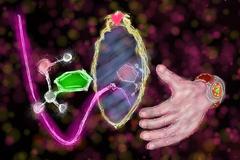URL: https://www.desy.de/news/news_search/index_eng.html
Breadcrumb Navigation
DESY News: Scientists make “handedness” appear using only microwave fields
News
News from the DESY research centre
Scientists make “handedness” appear using only microwave fields
DESY scientists have generated a geometric asymmetry of organic molecules using a custom developed microwave pulse scheme. The asymmetry, called chirality or “handedness”, plays a major role in biochemistry and medicine. The researchers took molecules of benzyl alcohol, which normally exists as a physically inseparable mixture of both asymmetric forms, and applied microwave radiation to break this symmetry and induce a prevalence of left- or right-handed version of the molecules. The results, published in the journal Nature Communications, could help provide a greater understanding for the roots of this phenomenon.

Chirality or 'handedness' is a property of organic molecules, in which nominally the same molecule can have a mirrored version of itself that can function completely differently biologically to its partner. Illustration: Denis Tikhonov, DESY
A group headed by DESY leading scientist Melanie Schnell created a brand-new approach to manipulating this asymmetry. They took a molecule that can switch between its left and right forms through a quantum tunneling effect and thus has no real distinction between the two forms. By applying a custom set of microwave pulses, the researchers were able to force the achiral molecule benzyl alcohol into a chosen rotational quantum state. This meant the molecule transitioned from a 50/50 mixture of left and right-handed versions to a mixture, where one of these forms is dominant.
“Our newly developed scheme provides a novel approach for manipulating molecular chirality in floppy transient chiral molecules and a new insight into the possible driving force breaking chiral symmetry at the molecular level,” says Wenhao Sun, a postdoc in Schnell’s lab who is the first author on the paper.
The method, following a six-wave mixing scheme, uses six different microwave pulses to change the molecule’s handedness and then enable observations of the changes. The first three pulses of the six induces the shift to either a left- or right-handed version of the molecule. The fourth and fifth pulses then are used to probe the manipulated molecule, which releases its own sixth pulse of microwaves carrying information about changes in its structure.
“The changes are entirely driven by effects of the microwaves on the rotational and vibrational states of the molecule,” says Sun. “This research goes into the direction of applying only electromagnetic fields to an achiral reagent, and controlling the chiral outcome of the chemical reaction.”
Figuring out how to induce these changes brings the scientists a step closer to understanding how and why this phenomenon occurs in biological systems. Details of the evolution of molecules in the early stages of life on Earth can become clearer with a better understanding of why handedness occurs in one way in certain molecules and in another way in others.
“That we have been able to do this important step towards controlling the chirality of a molecule at will helps to deeper understand biomolecular systems,” says Schnell.
Reference
Sun, W., Tikhonov, D.S., Singh, H. et al. Inducing transient enantiomeric excess in a molecular quantum racemic mixture with microwave fields. Nat Commun 14, 934 (2023). DOI: 10.1038/s41467-023-36653-3



